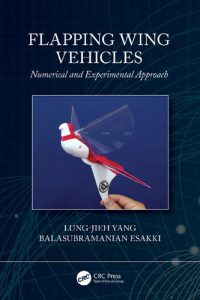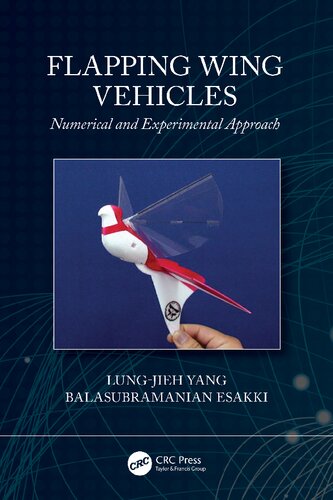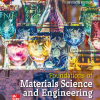Flapping Wing Vehicles: Numerical and Experimental Approach 1st Edition by Lung-Jieh Yang 9781000442632 1000442632
$50.00 Original price was: $50.00.$25.00Current price is: $25.00.
Flapping Wing Vehicles: Numerical and Experimental Approach 1st Edition Lung-Jieh Yang – Ebook Instant Download/Delivery ISBN(s): 9781000442632, 1000442632

Product details:
- ISBN 10: 1000442632
- ISBN 13:9781000442632
- Author: Lung-Jieh Yang
Flapping Wing Vehicles
Numerical and Experimental Approach
Table contents:
Chapter 1 Introduction to Micro Aerial Vehicles
1.1 Flapping Motion
1.2 Aspects of Fluid Mechanics and Aerodynamics in the Study of Flyers
1.2.1 Governing Equations of Fluids
1.2.2 Ideal Fluid Potential Flow
1.2.3 Dimensional Analysis
1.2.4 Viscous Flow ∼ Boundary-Layer Theory
1.2.5 Compressibility
1.2.6 Drag and Flight Power
1.2.6.1 Induced Drag
1.2.6.2 Total Drag
1.2.6.3 Flight Power
1.3 Flight Mechanics
1.3.1 The Dynamic Control of the Flapping Wing MAVs
1.3.2 Equations of Motion for Rigid Aircrafts
1.3.3 Steady-State and Perturbation State
1.3.4 Steady-state EoM
1.3.5 Linearized EoM
1.3.6 Aerodynamic Forces and Moments
1.3.7 Numerical Example for Longitudinal Modes
1.3.8 Numerical Example for Lateral Modes
1.3.9 Plate-Body Stability
1.4 Scaling Laws of Flapping Wings
1.4.1 Geometry Similarity
1.4.2 Scaling Laws of Bio-natural Flyers
1.5 Lift Mechanisms of Flapping Flight
1.5.1 Dimensionless Parameters of Flapping Wings
1.5.2 Unsteady Lift Mechanisms
1.5.3 Rotational Lift of Flapping Wings
1.5.4 Added Mass
1.5.5 Wing-Wake Interaction
1.6 Stability Issues of a Flapping Wing
1.6.1 C. G. of a Flapping Wing
1.6.2 Preliminary Review on Flight Dynamics Model of a Flapping Wing
1.6.3 Time-Averaging of Inertia for Flapping Wings
1.6.4 New Definition of Stability Derivatives Related to Flapping Frequency
1.6.5 New Control Way Other Than Elevator, Aileron, and Rudder
1.7 Summary
References
Chapter 2 In-Situ Lift Measurement Using PVDF Wing Sensor
2.1 Lift Measurement Using Wind Tunnel
2.2 Inertial Force Effect on Lift
2.3 Principle of Polyvinylidene Fluoride (PVDF)
2.4 Fabrication of Flapping Wings with PVDF Lift Sensors
2.4.1 Fabrication of Flapping Wing
2.4.2 Introduction of Parylene
2.5 Preliminary Wind Tunnel Test of Titanium-Parylene Wing
2.6 PVDF Sensor in Measuring the Lift Force of Flapping Wings
2.7 Flight Test
2.8 Summary
References
Chapter 3 Flapping Wing Mechanism Design
3.1 Golden-Snitch Ornithopter
3.1.1 Design of the Transmission Module
3.1.2 Aerodynamic Performance of theGolden-Snitch
3.1.3 Flight Test
3.2 Impact of Flapping Stroke Angle on Flapping Aerodynamics
3.3 Aerodynamic Characteristics of Golden-Snitch Pro
3.4 Watt-Stephens Mechanism
3.5 Evans Mechanism
3.5.1 Preliminary Design
3.5.1.1 Phase Lag
3.5.1.2 Force Transmission Angle
3.5.2 Improved Design of Evans Mechanism
3.5.3 Comparison of Stephenson Mechanisms and Evans Mechanism
3.5.4 Measurement of Flapping Frequency
3.5.5 Aerodynamic Performance Measurement of Evans Mechanism
3.5.6 Mass Distribution of FWMAV with Evans Mechanism
3.6 Flight Test of Evans-Based FWMAV
3.7 Summary
References
Chapter 4 Fabrication of Flapping Wing Micro Air Vehicles
4.1 Electrical Discharging Wire Cutting (EDWC)
4.1.1 Gold-Snitch Four-Bar Linkage (FBL) Mechanism by EDWC
4.1.2 EDWC of Evans Flapping Mechanism
4.2 Injection Molding
4.2.1 PIM of FBL Mechanism for Golden-Snitch
4.2.2 Development of Golden-Snitch Outer Body Using PIM
4.2.3 PIM of Evans Flapping Mechanism
4.3 Additive Manufacturing (3D Printing)
4.3.1 Fused Deposition Modeling (FDM)
4.3.2 Parylene Coating as a Solid Lubricant
4.3.3 Multijet Printing
4.3.4 Polyjet Printing
4.3.5 Stereolithography
4.4 Performance Comparison of Flapping Mechanisms by Different Manufactures
4.4.1 Torque of Evans Mechanism by PIM
4.4.2 3D Printing Evans Mechanism’s Performance Evaluation
4.5 Summary
References
Chapter 5 Flapping Wing Design
5.1 Strengthening of Leading-Edge in Flapping Wings
5.1.1 Aerodynamic Enhancement of the Leading-Edge Tape on Flapping Wings
5.1.2 Effect of Leading-Edge Tape on Power Consumption
5.2 Carbon-Fiber Rib Effect on the Flapping Wings
5.3 Effect of Materials and Stiffness on the Flapping Wings
5.3.1 Aerodynamic Performance of Various Wing Membranes
5.3.2 Power Consumption in Various Wing Membranes
5.4 Bionic Flapping Wings with Check Valves
5.4.1 Working Principle of Flapping Wings with Check Valves
5.4.2 Design of the Flapping Wings with Check Valves
5.4.3 Wind Tunnel Testing of a Flapping Wing with Check Valves
5.5 Bionic Corrugated Flapping Wings
5.5.1 Dragonfly Wing and Corrugations
5.5.2 Thickness Effect for Corrugated Wing
5.5.3 Design and Fabrication of a Corrugated Wing
5.5.4 Aerodynamic Performance Evaluation of a Corrugated Wing
5.5.5 Performance Evaluation at Cruising
5.6 Wing Stiffness of Different Flapping Wings
5.7 Summary
References
Chapter 6 Clap-and-Fling Flapping
6.1 Introduction
6.2 Mechanism Design for Clap-and-Fling Motion
6.2.1 CF-50 Mechanism Design with 50° Stroke Angle
6.2.2 CF-51 and CF-72 Mechanism Design
6.3 High-Speed Photography Test (Zero Wind Speed)
6.3.1 CF-50
6.3.2 CF-51
6.3.3 CF-72
6.4 Wind Tunnel Testing
6.4.1 CF-50
6.4.2 CF-51
6.4.3 CF-72
6.5 Aerodynamic Performance Comparison
6.6 Summary
References
Chapter 7 Computational Fluid Dynamics Analysis of Flapping Wings
7.1 Introduction
7.2 Numerical Simulation of Single Flapping Wing
7.2.1 Governing Equations
7.2.2 Boundary Conditions
7.2.3 Mesh Setting and Testing
7.2.4 Flow Pattern Comparison for Single Flapping Wing
7.2.5 Aerodynamic Force Comparison for Single Flapping Wing
7.2.6 Comparison of 3D Trajectory Using Stereo-Photography for Single Flapping Wing
7.2.7 Major Observations from CFD Analysis of Single Flapping Wing
7.3 Formation Flight of Flapping Wings
7.4 CFD Analysis of Formation Flight of FWMAVs
7.4.1 Model Generation
7.4.2 CFD Analysis for Single Flapping Wing
7.4.3 CFD Analysis for V-Formation with 3 Flapping Wings
7.4.4 Comparison of Averaged Lift Per Wing for V-Formation and Single Wing
7.4.5 Lift Comparison for Leading Wing of V-Formation and Single Wing
7.4.6 Lift Comparison for Leading Wing and Follower Wing of V-Formation
7.4.7 Comparison of Dimensionless Lift Coefficients
7.5 Summary on the V-Formation Flapping Flight
Summary
References
Chapter 8 Soap Film Flow Visualization of Flapping Wing Motion
8.1 Introduction
8.2 Methodology
8.2.1 Working Principle
8.2.2 Differential Approach about a Soap-Film
8.2.3 Integral Approach about a Soap-Film Using Stokes Theorem
8.2.4 The Integral Approach of a Soap-Film Using Gauss Theorem
8.2.5 Soap-Film Thickness Interpreted to 3D Downwash of a Wing
8.3 Soap-Film Imaging Experiment of a 10 cm-Span Flapping Wing
8.3.1 10 cm-Span Flapping Wing
8.3.2 Experiment Setup
8.3.3 High-Speed Photography for Capturing Soap-Film of a Flapping Wing Motion
8.3.4 RGB-Thickness Field Conversion
8.3.5 Calculation of 3D Downwash, Lift, and Induced Drag of a Flapping Wing
8.4 Summary
References
Chapter 9 Dynamics and Image-Based Control of Flapping Wing Micro Aerial Vehicles
9.1 Introduction to Stereovision System
9.2 Simplified Dynamic Model
9.2.1 Equations of Motion
9.2.2 Averaging Theory and Formulation of Forces
9.2.2.1 Applicability of Averaging Theory
9.2.2.2 Formulation of Forces and Moments
9.2.2.3 Coefficients of the Main Wing
9.2.2.4 Coefficients of the Horizontal Wing
9.3 Control Law Design
9.3.1 Linearized Dynamics
9.3.2 Formulation of the Transfer Function
9.4 Numerical Simulations
9.5 Experiments and Discussion
9.6 Vision-based Control
9.7 Experimental Studies Using Developed Image Processing Algorithms
9.8 Development of Graphical User Interface
9.8.1 Manual Mode
9.8.2 Hardware Setting
9.8.3 Vision-Based Control Mode
9.9 Vision System for FWMAV
9.10 Motion Estimation Using Frequency Domain Approach
9.11 Group Actuation and Control
9.12 Summary
References
Chapter 10 Arduino-Based Flight Control of Ornithopters
10.1 Estimation of Attitude, Altitude, and Direction of FWMAV
10.2 Directional Control of FWMAV with Microcontroller and On-Board Avionics
10.3 Flight Test
10.3.1 Altitude Measurement
10.3.2 Measurement of Flight Data
10.4 Design of Printed Circuit Board
10.4.1 Uploading Firmware
10.4.2 Sensor Data
10.5 Flight Test
10.6 Bionic Actuators for FWMAVs
10.6.1 Working Principle of Bionic Actuators
10.6.2 Design of Bionic Actuator
10.6.3 Fabrication and Testing
10.7 Summary
References
Chapter 11 Servo Driven Flapping Wing Vehicles
11.1 Introduction of Servomotors
Specification of the Servo
11.2 Design of Servo Mount
11.3 Flight Control of Servo-Driven Flapping Wings
11.4 Tethered Flight
11.5 Attitude Control of Servo-Driven Ornithopter
11.6 Experimental Analysis
11.7 Design of Long Wingspan Servo-Driven Ornithopter
11.8 Lightweight Batteries for FWMAVs
11.9 Summary
References
Chapter 12 Figure-of-Eight Motion and Flapping Wing Rotation
12.1 Introduction
12.2 Passive Wing Rotation of Flapping
12.2.1 Review on Tamkang’s Golden-Snitch
12.2.2 Joint Wearing of Flapping Mechanism
12.2.3 Oblique Figure-of-8 Flapping Characteristics of Golden-Snitch
12.2.4 Symmetry Breaking of Flapping Dynamics
12.3 Active Wing Rotation of Flapping
12.3.1 Lift-Generation Principle for Wing Rotation of Flapping
12.3.2 Flapping Mechanisms with Wing Rotation
12.3.3 Type A: All Servo Mechanism
12.3.4 Type A1: Normal Servo Mechanism
12.3.5 Type B: Servo-Bevel Gear Hybrid Mechanism
12.3.6 Type B1: Hybrid Servo-Bevel Gear Mechanism with Stoppers
12.3.7 FBL-Bevel Gear Hybrid Mechanism
12.3.8 Major Inferences
12.4 Power Consumption of Flapping-Wing Flight
12.5 Summary and Final Conclusion
People also search:
flapping wing vehicles: numerical and experimental
flapping wing mechanism
flapping wing
flapping wing aircraft
flapping wing drone
You may also like…
Uncategorized
Jurisprudence & Law - Legal Theory & Philosophy
Technique - Electronics: Robotics
Astronomy - Outer Space - Observation & Exploration
Computers - Computer Science
Numerical Analysis A Programming Approach 1st Edition Vachharajani
Engineering - Robotics & Artificial Intelligence
Autonomous Underwater Vehicles Jing Yan Xian Yang Haiyan Zhao Xiaoyuan Luo Xinping Guan












